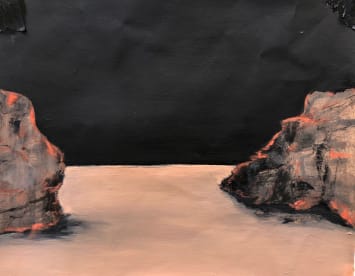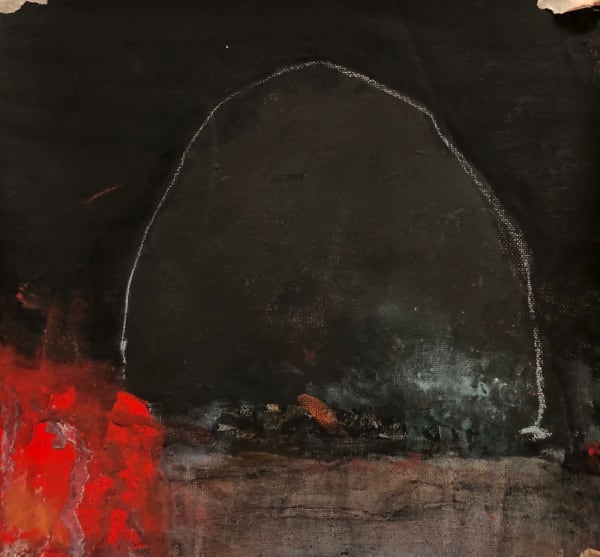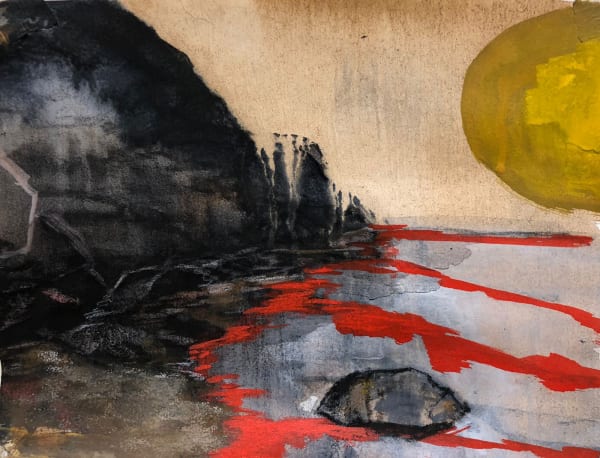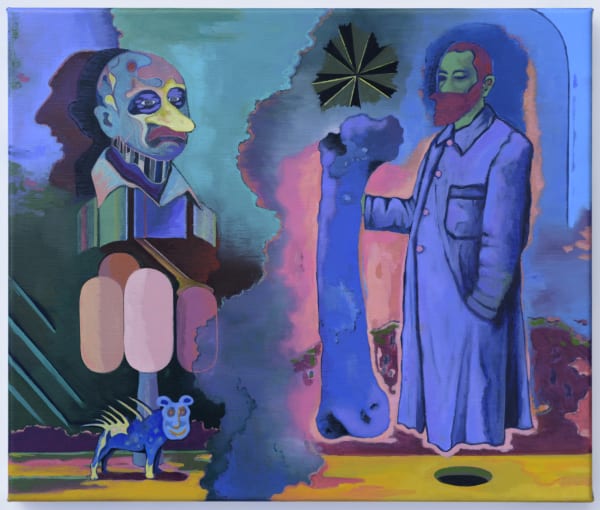Gypsum is pleased to present The Cheating Hand of Randomness, a group exhibition showcasing work created at the juncture of chance and intentionality. Featuring painting, film and photography by Tamara Al Samerraei, Basim Magdy and Cyrus Mahboubian, the exhibition takes as its thematic thread the common methodological approaches of the artists, whose practices involve varied iterations of spontaneous gathering, and deliberate assembly. In making way for liminality in their art-making, the artists allow for a relational and responsive creative process to emerge, one that emphasizes material agency, and is perhaps more suited to our current moment of collective uncertainty. A preoccupation with vast landscapes devoid of human inhabitants further connects the artworks, which seemingly reflect a post-anthropocene world, at times brooding and melancholic, at others playful and serene.
In a series of ten new, small-scale acrylic on canvas paintings, Tamara Al Samerraei engages in a minimalist rendering of alien landscapes. Vast vistas display opaque pools, fiery orange accents settle on jagged rocks, while veins of red snake across ethereal plains. Created in parallel with Al Samerraei’s work on larger scale paintings, these landscapes are executed on leftover canvas scraps. They embody a formal experimentation that sees the artist work outside of a pre-planned schema, allowing for a more genuine, uninhibited process to emerge, unhampered by the artist’s expectations.
In his film M.A.G.N.E.T . (2019) Basim Magdy creates a world in which the grounding force of gravity goes berserk, intensifying its unrelenting pull on objects towards the earth’s underbelly, and pulling humanity — doomed to repeat its errors under the guise of progress — to a future fate eerily reminiscent of the present. In this atemporal world, forgotten monoliths carry messages from distant ancestors, while roaring magma portends ecological and financial disaster for a society unburdened by memory, weighed down by shortsightedness. Like much of the artist’s work, the film is comprised of material shot during Magdy’s travels, which is then assembled outside the confines of a linear filmic narrative. Accompanying the film is a new painting by Magdy — The Man who Stole a Bone from the Sahara Confronted by the Shadow of War — inspired by the unfortunate tale of a German paleontologist’s early 20th century excavation in Egypt, and executed in the artist’s signature fluorescent hues.
Cyrus Mahboubian presents a sequence of delicately grafted minute black and white polaroid composites, reflecting forested, shadowy terrains. The attentively selected frames are captured during Mahboubian’s otherwise unplanned countryside walks, whose meandering routes the artist sees as a meditative resistance to the demands of urban living, and the clamour of technological ubiquity. Often pulling from his preexisting archive for the creation of the composites, the artist merges and juxtaposes fragments of standalone images to create gossamer, diptych worlds.
The exhibited works foreground material agency, spotlighting the role of the artists’ chosen medium as an active participant in their artmaking. Whether through the grainy, painterly qualities of Super 16mm film used by Magdy, the scarcity of the polaroid film stock used sparingly by Mahboubian, or the smaller scale demanded by the canvas scraps of Al Samerraei, the availability and physical properties of their chosen materials exert a tangible influence on each artist’s process, subjecting the results to another layer of chance and conditionality.


















